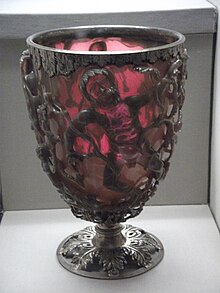 The 4th-century Lycurgus Cup, a 4th-century Roman glass cage cup made of a dichroic glass
The 4th-century Lycurgus Cup, a 4th-century Roman glass cage cup made of a dichroic glassI had a project to complete and the brief for the project was "Historical Glass Beads, "Valentine's Day" theme. My immediate thoughts were "pink" and "love hearts". Neither of these have much evidence across the pre 16th century world, so I decided on "red" and "white", and a couple of love heart shapes on the beads on the premise that feathering and odd shapes do ocasionally turn up.
I thought I might collate any evidence of pink glass here. Any questions or additional sources, please feel free to add.
Wikipedia: Cranberry Glass
https://en.wikipedia.org/wiki/Cranberry_glass
The origins of cranberry glass making are unknown, but many historians believe a form of this glass was first made in the late Roman Empire. This is evidenced by the British Museum's collection Lycurgus Cup, a 4th-century Roman glass cage cup made of a dichroic glass, which shows a different colour depending on whether light is passing through it or reflecting from it; red (gold salts) when lit from behind and green (silver salts) when lit from in front.[2][3] Kitab al-Asrar, an Arabic work attributed to Abu Bakr al-Razi contains one of the earliest modern descriptions of the preparation of gold ruby glass.[4][5]
